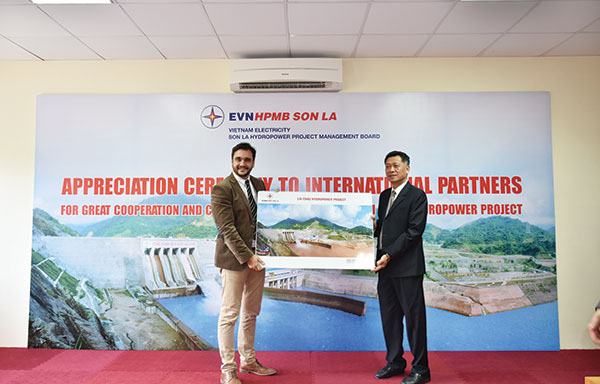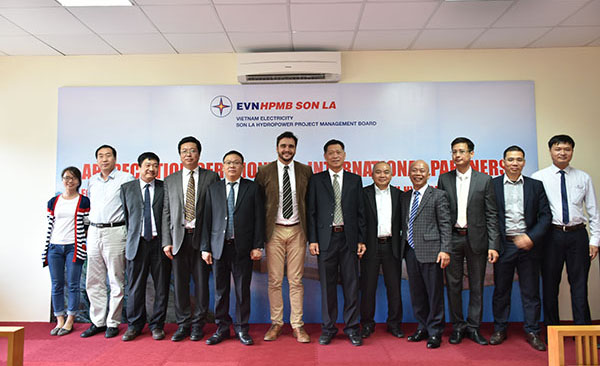Lai Chau hydropower plant is a bold new indicator of Vietnam’s clean energy pledge
 |
| GE’s manufacturing unit worked 24 hours a day to meet the production schedule for the Son La plant |
The Lai Chau success
Construction of Lai Chau Hydropower Plant started on January 5, 2011, with three units planned with a designed capacity of 1,200 megawatts (MW). When it fully comes into operation, it will provide about 4.7 billion kWh per year to the national grid. This is one of the four hydropower plants planned on the Da River.
In terms of scale, the plant is the third biggest hydropower plant in Southeast Asia, only after 2,400MW Son La Hydropower Plant and the 1,920MW Hoa Binh Hydropower Plant.
At Lai Chau Hydropower Plant, GE was responsible for the design, supplying, guiding the installation, and commissioning of three 400MW Francis hydro turbines, the generator, speed governor, as well as the static excitation and plant control systems.
The equipment and system used for the plant, namely the ALSPA system for the speed governor, excitation system, and plant control system, is the most advanced technology available at the moment. In Vietnam, this technology has been applied in Son La, Huoi Quang, Lai Chau, Da Nhim, Dai Ninh, Sesan 4 hydropower plants and will also be continued for Thac Mo Extension and Tri An Hydropower Plant.
According to Fabio Nossaes, general manager of Hydro at GE Renewable Energy, the project was completed one year ahead of schedule in a big part thanks to the experience the group acquired after working on Son La Hydropower Plant, the last unit of which started operation in 2012.
“The Lai Chau plant uses the same technical parameters as the Son La plant, making it unnecessary to re-do the hydraulic study, as well as the development and model tests. This shortened the time needed to carry out the project by six months,” said Nossaes.
Right after the project started, GE got to work on strategic planning for the design, material procurement, manufacture, and shipment.
“The components have big dimension and weight, so they must be transported by waterways through the Da River which cannot accommodate ships from January to June every year. Therefore, GE had to optimise the manufacturing and transportation plans to deliver the goods to Haiphong Port at the appropriate time,” he explained.
Therefore, the company gave priority for the manufacturing of equipment for the Lai Chau plant in its factory. At critical moments the management made quick decisions enabling the manufactory workshop to keep to the schedule.
Moreover, because the team working on the Lai Chau plant was the same that was earlier involved in equipping the Son La plant, it made the process a lot easier.
“This was very important as it allowed smooth communication among GE departments, the external customer, and technical design and consultancy teams,” Nossaes said.
The early completion brings a lot of benefits to the country. Besides the additional 4.7 billion kWh, the shortened construction time meant savings, pushing total benefits to VND7 trillion ($307 million).
 |
Building a legacy
GE’s success at the Lai Chau plant followed earlier success at the Son La plant, which the team had achieved under even tougher conditions. The Son La plant was the most important and biggest hydropower project in Vietnam as it would contribute about 10 per cent of the national grid’s total capacity.
“Time was very tight - three years from when the contract became effective to when the first unit started generation. It put significant pressure on EVN, GE, and all construction partners,” Nossaes recalled.
Meanwhile, information on the interface between the civil work and the equipment sides took a longer time to proceed. On top of these challenges, some local policies and standards were not presented in the contract. For example, for the arrangement of the plant’s fire fighting system, there is a big difference between international standards and local standards. GE had to modify the design to adapt to local regulations.
“Vietnamese standards often follow Russian ones, which were very different from international and GE standards,” he explained.
GE identified quality assurance and delivery on time as its top priorities. “Being greenlighted by the management of GE, we decided to start the hydraulic study in advance to develop the most advanced model for the plant, and to purchase the steel plates for the fabrication of the stay ring and the spiral case - the vital parts - in advance because the time between finishing one unit and the next was only 40 days in the contract, much shorter than the usual 120 days,” said Nossaes
Finally, the model was proved high performance and very stable and GE delivered six units of stay rings and spiral cases earlier than scheduled.
Time was not the only constraint for the team. Again, due to the limitation of the road from Haiphong Port to the Son La plant site, certain heavy and big components, such as the turbine runner, shaft, and turbine head cover, had to be transported by waterway. However, the water level in Da River is very low in the dry season - between January and June - effectively closing it off.
GE knew it had to have a very good fabrication and delivery plan. It was critical to manufacture and deliver Unit 6’s turbine runner within a very limited time window due to restrictions on transportation. Therefore, GE set up a special team that would focus on the fabrication and worked 24 hours a day for two months.
Moreover, to ensure the progress of site installation, GE time and again arranged urgent delivery by truck through the border between China and Vietnam. Thanks to these initiatives, GE successfully finished the Son La plant on time.
Sharing his thoughts on these two projects, Nguyen Cuong Lam, vice general director of EVN said: “We understand that the plant capacity increase is an urgent task to be accomplished when primary power sources are gradually dwindling and hydropower potential is almost fully exploited. Lai Chau Hydropower Plant’s completion one year ahead of schedule is a remarkable achievement that will result in numerous socio-economic benefits for the areas and the country. We look forward to having more fruitful partnership with GE for many more future successes.”
According to Nossaes, the success of first Son La then Lai Chau reconfirmed to EVN and the Vietnamese government that GE is a committed company that respects the customer and strives to deliver the project in full according to its commitment.
“To take part in these two projects, we are asserting our engagement to grow in tandem with Vietnam. As renewable energy is emerging worldwide, we are present here in Vietnam to help Vietnamese approach to cleaner and greener energy for sustainable development,” Nossaes said.
What the stars mean:
★ Poor ★ ★ Promising ★★★ Good ★★★★ Very good ★★★★★ Exceptional
Latest News
More News
- Addressing Vietnam's energy challenges with aeroderivative gas turbines (February 28, 2023 | 09:33)
- How to sprint ahead in 2023’s worldwide energy priorities (February 08, 2023 | 13:55)
- Boosting Vietnam's grid stability through gas turbine technology (November 22, 2022 | 20:02)
- Healthcare trio collaborates to provide thousands of free breast scans (October 27, 2022 | 17:19)
- GE Healthcare's vision for AI-backed radiology (September 29, 2022 | 11:53)
- GE brand trio to shape the future of key industries (July 19, 2022 | 15:35)
- GE unveiling brand names and defining future (July 19, 2022 | 15:16)
- GE: the shortest route towards sustainability (July 18, 2022 | 08:00)
- Be proactive in an uncertain world (May 20, 2022 | 11:40)
- GE secures first 9HA combined cycle power plant order in Vietnam (May 16, 2022 | 17:06)


















 Mobile Version
Mobile Version